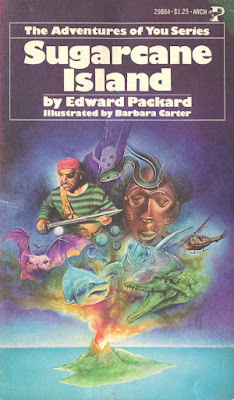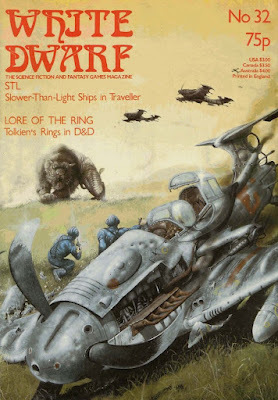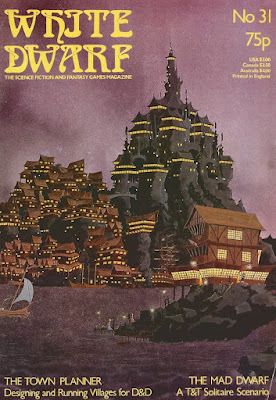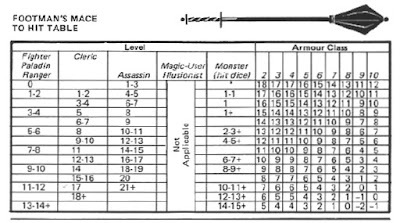James Maliszewski's Blog, page 112
March 31, 2022
Retrospective: Sugarcane Island
 It's funny the memories that stick with you, even after so many decades. When I was in the third grade, my teacher invited a public librarian to come and visit our classroom. The purpose of his visit was twofold. First, he wanted to encourage us to come to our local library to get library cards (I needed no encouragement in this regard, having been an avid visitor of public libraries since I was quite young). Second, he wanted to share with us some books that he thought we might like. I cannot recall most of the books the librarian recommended to us on that day, but one still stands out: Sugarcane Island by Edward Packard.
It's funny the memories that stick with you, even after so many decades. When I was in the third grade, my teacher invited a public librarian to come and visit our classroom. The purpose of his visit was twofold. First, he wanted to encourage us to come to our local library to get library cards (I needed no encouragement in this regard, having been an avid visitor of public libraries since I was quite young). Second, he wanted to share with us some books that he thought we might like. I cannot recall most of the books the librarian recommended to us on that day, but one still stands out: Sugarcane Island by Edward Packard.Context is important here. The librarian's visit probably took place in the spring of 1978. At that time, no one had ever heard of a Choose Your Own Adventure book. That famous series didn't even come into existence until 1979, shortly before I first encountered the D&D Basic Set. Consequently, when the librarian described Sugarcane Island as a book in which I, the reader was the main character (or words to that effect), I was simultaneously baffled and intrigued. I'd never heard of a book like that and my eight year-old brain initially struggled to understand what he meant. It was only after he'd read a portion of it to us and allowed our class – by majority vote! – to decide which choices to make in the unfolding narrative that intrigue won out over bafflement. I had to read this book for myself.
I eventually was able to snag a copy of Sugarcane Island at the library, along with Deadwood City, another proto-CYOA book by the same author. The premise of Sugarcane Island is that the reader is an assistant to a scientist on an expedition to the Galapagos Islands made famous in the English-speaking world by the voyage of Charles Darwin aboard the HMS Beagle. The ship on which you are traveling encounters a bad storm during the night, resulting in your being washed overboard. When you wake up the next morning, you find yourself on the beach of a strange island, the only distinguishing feature being the sugarcane that grows nearby, hence the title of the book.
The "story" of Sugarcane Island is thus one first of survival – you must locate food, water, and shelter – and then of discovery and escape. Your choices determine where you go and what find on the island and that alone was intoxicating to me as a child. I'd never read a book that allowed me to decide where the protagonist went and what he did. That alone was enough to get me to read through it several times in the span of a single day, making different choices each time, trying to see what the "best" course of action was. That was the real appeal of Sugarcane Island for me: it was like a game.
Eventually, though, I found the limited choices and occasionally arbitrary nature of outcomes to be frustrating. The book's promise of open-endedness was somewhat illusory and it quickly became clear that Packard had decided in advance that there were "right" and "wrong" decisions. That's perfectly understandable, of course, given the inherent limitations of a printed book. Indeed, that's one of the difficulties of all Choose Your Own Adventure Books and their modern descendants, such as computer RPGs: there's simply no practical way to consider every possible choice. Sure, the author can include the most obvious choices and options and, for most readers, that's probably enough. But what if you want to do something unexpected or even downright weird? In that case, you're out of luck.
As I believe I've mentioned elsewhere, I was not a big reader of Choose Your Own Adventure books (aside from the excellent Fighting Fantasy books). To a great extent, this is simply a factor of history: most of the volumes released under that banner didn't come out until after the time I was already playing roleplaying games and they paled in comparison to the fun I had playing D&D or Gamma World. At the same time, it's not incorrect to say that Sugarcane Island paved the way for my eventual embrace of RPGs. In a very real sense, this book made me aware of a desire I didn't even know I had, namely, to determine the choices a protagonist makes in an unfolding story. That Sugarcane Island failed to satisfy that desire fully is no knock against it, which was (and is) a genuinely groundbreaking children's book. I'm very grateful to that nameless librarian who visited my school more than four decades ago. Without him, who knows whether I'd ever have become involved in this hobby that still gives me so much joy more than four decades later?
March 29, 2022
Units of Measurement
 Development of The Secrets of sha-Arthan continues and, as it slowly evolves away from its origins in Dungeons & Dragons (and Old School Essentials), I've started pondering certain questions I would never before have considered. One of these is the matter of units of measurement.
Development of The Secrets of sha-Arthan continues and, as it slowly evolves away from its origins in Dungeons & Dragons (and Old School Essentials), I've started pondering certain questions I would never before have considered. One of these is the matter of units of measurement.With the notable exception of RuneQuest, most fantasy roleplaying games have employed US customary or Imperial units (or some mix of the two). On the other hand, science fiction roleplaying games are (almost) unanimous in using the metric system. Now, sha-Arthan is a "secret sci-fi" setting, which is to say, it's presented as if it were a traditional fantasy setting, albeit a somewhat exotic one, but its foundations are science fictional. Thus, there are scientific – or at least pseudo-scientific – explanations for sorcery, monsters, magic items, and so on. Since it occupies a middle ground between fantasy and science fiction, what sort of units of measurement should it use?
This has been a topic of conversation among my patrons, where a vocal (and persuasive) minority suggested that I ought to consider creating unique units of measurement for the setting, both for flavor purposes and to aid in the running of the game. I must admit that I was immediately torn by this suggestion. It's certainly true that unique terms can help to better immerse one in an imaginary setting. However, they can also be alienating, especially when there are already lots of unique terms and names in use.
One possible way to bridge the gap between these two perspectives is to come up with terms that are both easily convertible to real world units and useful in play. For example, the six-mile hex is very popular among old school gamers and, while there are indeed some practical reasons for its popularity, it's still a somewhat arbitrary choice. But what if it weren't? What if, in sha-Arthan, there was a unit of measurement that corresponded to six miles (let's call it a meshal for argument's sake)? If that were the case, I could simply say that each hex on a map corresponds to one meshal and then explain how many meshals per day a group of adventurers can typically travel. In a similar fashion, if I adopt five-foot squares on interior maps, perhaps each of those squares is another type of unit (a dashur or "pace"). As I ponder this further, I realize that I could come up with other units to simplify the handling of encumbrance or whatever other "fiddly" details of fantasy gaming that are often cast aside because of the tedium of keeping track of them.
Of course, I might well be mistaken in this and that any theoretical gains made through the use of game-derived units is offset by the additional step of remembering just what a meshal or dashur represents. It's also possible that it's just this kind of world building that gets in the way of accessibility and one of my goals with sha-Arthan is to present an exotic science fantasy setting that isn't going to frighten people away by luxuriating in its own oddities.
I shall keep pondering.
White Dwarf: Issue #32
 Issue #32 of White Dwarf (August 1982) is both the very first monthly issue of the magazine and the first issue I ever owned. I bought it while traveling with my family a couple of months before my thirteenth birthday. I'd heard of White Dwarf, of course, and might even have seen a copy or two in the possession of the older roleplayers I knew, but I can't recall ever reading an issue cover to cover before this one. Consequently, reaching this issue in this series represents an important milestone: the point where my knowledge of the issues I'm discussing is founded on past experience.
Issue #32 of White Dwarf (August 1982) is both the very first monthly issue of the magazine and the first issue I ever owned. I bought it while traveling with my family a couple of months before my thirteenth birthday. I'd heard of White Dwarf, of course, and might even have seen a copy or two in the possession of the older roleplayers I knew, but I can't recall ever reading an issue cover to cover before this one. Consequently, reaching this issue in this series represents an important milestone: the point where my knowledge of the issues I'm discussing is founded on past experience.This issue had a lasting effect on my imagination, in part because of its outstanding cover by Jim Burns. I really taken with its depiction of retro-futuristic prop fighter planes, not to mention the two downed airmen facing off against an alien tiger-thing. I can't imagine how much time I spent staring at this cover, picking out details and trying to figure out a way to work a scenario like this into one of my games (which I finally did in a Traveller campaign set on a TL5 world).
The issue begins with an odd article that nevertheless fascinated me at the time. Entitled "Lore of the Ring" by Stephen Bland, it provides D&D stats for Tolkien's rings of power, as well as the Nâzgul and their winged steeds. Needless to say, it's all a bit silly, inasmuch as I can't really see any circumstance where a D&D referee would seriously consider including even one of the lesser rings in his campaign. On the other hand, the Nâzgul are undeniably cool, especially when accompanied by one of Russ Nicholson's illustrations. I never made use any Nâzgul either, but, believe me, I was tempted ...
Next up is "STL: Slower-Than-Light Ships in Traveller" by Marcus Rowland. I loved this article, too, which includes an overview of the topic, rules expansions for use with the Traveller starship construction rules, sample STL ships, and several patron encounters. It's very well done and succeeded in piquing my youthful interest in ramships and lightjammers. Also related to Traveller is "Striker: Design of Civilian Vehicles for Traveller" by Bob McWilliams. The author talks briefly about the vehicle design system of Striker and how complex they are (an understatement). He then presents a vehicle design of his own – a gravcar – and kicks off a design competition, in which he asks readers to submit their own Striker designs. How I wanted to participate in this contest! Unfortunately, I never saw a copy of the rules until many years later, so this dream was unattainable.
Paul Vernon's "The Town Planner" continues with another installment, "Designing Towns and Cities." He focuses on several related topics, such as background, topography, population, and denizens, all of which Vernon then uses to offer advice on drawing and keying a map of the place. It's good stuff; I loved this as a kid. My only complaint is that it's too short and could easily have occupied many more pages. "A World of Your Own" is a short article by none other than Ken St. Andre, in which he, in between snarking about Dungeons & Dragons, counsels readers to make Tunnels & Trolls their own by changing it in any way that suits them. I find it hard to argue with him, but then I largely feel the same about any RPG.
"Open Box" offers just four reviews this month, starting with Call of Cthulhu by Chaosium. The reviewer is effusive in his praise and gives it a 9 out of 10. Bushido and its only published adventure, Valley of the Mists, meanwhile both receive perfect scores. I admire Bushido as much as the next guy, but is it really a better game than Call of Cthulhu? Finally, there's the Mattel D&D electronic game, which receives a 4 out of 10. I have a strange fondness for this game born out of fond memories, but even I have to admit that, objectively speaking, it's not a very good game, even by the primitive standards of electronic games in the early 1980s.
"Chaos from Mount Dorren" by Phil Masters is a fun little AD&D "mini-scenario" of the type that White Dwarf so frequently published. The characters come across a prosperous little town whose caravans are being attacked by unknown assailants. The town's rulers offer a reward to anyone who can get to the bottom of this. The basic scenario is a well-worn one but Masters offers enough twists and turns that it still feels fresh. "Rune Rites" provides game stats for a monster (the cyclops) and Griselda, one of the signature characters in Oliver Dickinson's delightful Pavis stories from previous issues.
"Fiend Factory" focuses this time on "Little Things" by providing statistics for five small monsters for use with D&D. Because I have a soft spot for low-level monsters, I've always liked this article. I'm particularly fond of the wyrmlets – weird disc-shaped monsters with arms and legs that can combine to form a more powerful wyrmling with powers commensurate with the number of wyrmlets that join together. The issue ends with "Drug Use and Abuse in D&D," which, I must confess, never did much for me. Author Graeme Davis provides some basic rules for addiction, along with several examples of fantasy narcotics. I have little doubt this might be useful in some campaigns, but I never made use of them in my own.
And there we have it: the first issue of White Dwarf I ever owned. Re-reading it for this post, I think it holds up quite well, being a good mix of authors and topics. This was the issue that kept me on the look-out for additional issues in the months to come. I'm glad to see that, unlike some things I once adored as a younger person, this one still holds up decades later.
March 28, 2022
GC S8/X2?
While flipping through issue #71 of Dragon (March 1983), I came across a strange little snippet of information that either overlooked before or that I'd simply forgotten. At the beginning of his article on the quasi-deities of the World of Greyhawk, Gary Gygax says the following:

From the very beginning, TSR's Dungeons & Dragons modules have carried alphanumeric codes that divided them into series. Each series was, with a few exceptions, focused on a specific subject matter or style of play, such as the B-series for low-level (beginner) characters or the D-series focusing on the machinations of the Drow.
Starting with the release of The Forgotten Temple of Tharizdun in 1982, these designations started to become much less clear-cut. Tharizdun was designated module WG4, the very first module to carry the "WG" code, which presumably stood for "World of Greyhawk." Two more more modules with Gygax's byline followed with this same code (Mordenkainen's Fantastic Adventure and Isle of the Ape), but there were never any modules with the codes WG1–3. (It's my understanding that The Village of Hommlet is WG1, the never-made Gygaxian Temple of Elemental Evil WG2, and The Lost Caverns of Tsojcanth WG3, though why this is the case, I have no idea.)
All of that is confusing enough if, like me, you care at all about the minutiae of TSR's production and releases. However, in the excerpt above, Gygax refers to The Land Beyond the Magic Mirror as "module GC S8/X2." Let's leave aside the fact that the actual published version of the module carries the designation EX2. That still leaves me wondering what Gygax's stated designation of the module even means. "GC," I suppose, is a reference to "Greyhawk Castle," which makes some sense, given that, in his original campaign, there was a section inspired by Alice's Adventures in Wonderland. But what are we to make of "S8/X2?"
In 1982, the S-series of modules already existed, but S4 was the highest-numbered entry. Likewise, there was an X-series but it was not associated with the AD&D line. Consequently, it seems unlikely that Gygax is referring to either of these series. I wonder if it might be the case that the numbers refer to the way he keyed Castle Greyhawk in his home campaign. If so, I'm not at all familiar with the way he did this and, absent that context, it's quite obscure.
If anyone has any insight into this, I'd love to know. In the grand scheme of things, it's a very minor mystery, but it's nevertheless one that has piqued my interest.
March 27, 2022
Pulp Fantasy Library: The Pool of the Black One

If much of contemporary discussion of pulp fantasy literature is to be believed, there are only two kinds of these tales: ground-breaking stories that transcend their origins or worthless hackwork without any enduring value. Now, I have no difficulty in acknowledging the existence of these two categories and could easily cite examples of stories I've read that fall into each of them. For me, the problem lies not so much in the categories themselves as in the seeming inability of some to admit any middle ground between them. As with so many things, there are shades of gray.
I mention this because of the story I wish to bring to your attention today, Robert E. Howard's "The Pool of the Black One," which first appeared in the October 1933 issue of Weird Tales. No one, I think, considers this one of Howard's best Conan yarns, especially when compared to, say, "The Tower of the Elephant," which appeared earlier in the same year. At the same time, comparing "The Pool of the Black One" to Howard's unarguably best efforts is not only unfair but misses a larger point about the purpose of pulp fantasy literature (or any pulp literature, come to think of it), namely, escapism.
Don't misunderstand me: I'd much rather that every Conan story were "Red Nails" rather than "The Devil in Iron." That this is not the case says little about the quality of "The Devil in Iron" than it does about our own expectation that every pulp fantasy tale be one that we can read again and again, finding something new in it each time. There's nothing wrong with ephemeral, unexceptional stories so long as we find them diverting while we're reading them. Put another way: not every work of literature must have enduring value to be worthy of our time. Sometimes – often even – it's enough that we enjoy it.
"The Pool of the Black One" begins memorably, with Conan climbing onto the deck of a pirate vessel, where the captain's mistress, Sancha, is sunning herself garbed only in a "short silk kirtle [that] veiled little of her voluptuous contours."
But at that instant a sound reached her ears unlike the creaking of timbers, thrum of cordage and lap of waves. She sat up, her gaze fixed on the rail, over which, to her amazement, a dripping figure clambered. Her dark eyes opened wide, her red lips parted in an O of surprise. The intruder was a stranger to her. Water ran in rivulets from his great shoulders and down his heavy arms. His single garment—a pair of bright crimson silk breeks—was soaking wet, as was his broad gold-buckled girdle and the sheathed sword it supported. As he stood at the rail, the rising sun etched him like a great bronze statue. He ran his fingers through his streaming black mane, and his blue eyes lit as they rested on the girl.Say what you will, but Conan can make quite an entrance. His arrival causes quite a stir on the vessel, a pirate ship whose name is the Wastrel we soon learn. Its captain, a Zingaran named Zaporavo, confronts the Cimmerian and asks him first his name and then "how did you get aboard my ship?" Conan replies in a delightfully laconic way, "I swam."
"Who are you?" she demanded. "Whence did you come?"
Zaporavo asks Conan,
"Why should I burden myself with every nameless vagabond that the sea casts up?" snarled Zaporavo, his look and manner more insulting than his words.
"A ship can always use another good sailor," answered the other without resentment. Zaporavo scowled, knowing the truth of that assertion. He hesitated, and doing so, lost his ship, his command, his girl, and his life. But of course he could not see into the future, and to him Conan was only another wastrel, cast up, as he put it, by the sea. He did not like the man; yet the fellow had given him no provocation. His manner was not insolent, though rather more confident than Zaporavo liked to see.
"You'll work for your keep," snarled the Hawk. "Get off the poop. And remember, the only law here is my will."
One might uncharitably call "The Pool of the Black One" formulaic. In the span of a couple of pages, Howard tells the reader exactly where he's taking this story. Zaporavo is a dead man walking and soon Conan will not only take his place as captain of this band of pirates but also his woman. Is it a bad story because of this? From a certain high-minded point of view, perhaps it is, but I think this perspective overlooks the pleasure to be found in seeing how a particular instance of a well-worn formula unfolds.
Conan soon wins the respect and admiration of the crew (and Sancha), much to Zaporavo's dismay.
He mixed with the crew, lived and made merry as they did. He proved himself a skilled sailor, and by far the strongest man any of them had seen. He did the work of three men, and was always first to spring to any heavy or dangerous task. His mates began to rely upon him. He did not quarrel with them, and they were careful not to quarrel with him. He gambled with them, putting up his girdle and sheath for a stake, won their money and weapons, and gave them back with a laugh. The crew instinctively looked toward him as the leader of the forecastle.In time, the Wastrel drops anchor off a mysterious island, where "the wind brought scents of fresh vegetation and spices." Zaporavo orders everyone ashore, except for Sancha, whom he commands to stay behind. She's understandably angered by this but nevertheless obeys. From her vantage point aboard the ship, she watches the pirates as they climb the trees along the beach and take the fruits from their branches. She also observes Zaporavo head into the jungle alone, followed not long after by Conan. This strange turn of events piques her interest and she decides to swim secretly to the island to find out what these two men are doing away from prying eyes.
Zaporavo, we're told,
desired to learn if this island were indeed that mentioned in the mysterious Book of Skelos, whereon, nameless sages aver, strange monsters guard crupts filled with hieroglyph-carven gold. Nor, for murky reasons of his own, did he wish to share his knowledge, if it were true, with any one, much less his own crew.For his part, Conan follows the captain solely for the purpose of killing him without any witnesses, which he succeeds in doing, as Howard already stated he would. Elsewhere, the crew fall fast asleep, seemingly as a result of the golden fruits they've eaten. This enables Sancha to make her way across the beach without anyone seeing her and then into the jungle, where she stumbles upon Zaporavo's dead body with a "gaping wound in his breast."
The young woman is not shocked to see this and "did not weep or feel any need for weeping." Instead, she looks for Conan, assuming he would be nearby. Instead, she finds someone else.
Unbelieving horror dilated her brown eyes. Her red lips parted to an inarticulate scream. Paralysis gripped her limbs; where she had such desperate need of swift flight, she could not move. She could only shriek wordlessly.As it turns out, the late Zaporavo was more right about the nature of this island than he would ever know. The remainder of the tale is spent chronicling Conan's exploration of the island and his discovery of just who dwells here and what their plans are for the hapless pirate crew and, of course, the beauteous Sancha.
"The Pool of the Black One" is a by-the-numbers Conan story, written because Howard needed money and he knew the kind of story that would be quickly accepted by Weird Tales. In that sense, it's nothing special and there are few surprises in its narrative. Nevertheless, I found it fun. It's simply a fast-paced, adventuresome yarn in which the reader gets to see Conan be Conan and all that that entails. Sometimes, that's enough.
March 26, 2022
Grognard's Grimoire: Lometlak
The Makers left behind innumerable automatons to defend and maintain their edifices, among the weakest beingthe single-minded lometlak. Broad and squat (5’), lometlak patrol both the Vaults and ancient sites on the surface of sha-Arthan. They relentlessly attack anyone unable to produce evidence ofsanction to enter the areas they guard, employing both physical attacks and a powerful energy weapon (range 180’).
DR 17, HD 4** (18hp), Att 2 × blow (1d8) or energy blast (2d6), AB +3, MV 90' (30'), SV F10 D11 M12 E13 S14 (4), ML 12, XP 175, NA 1d4 (1d4), TT None
Detect invisible creatures: Within 60’. Spell immunity: Immune to mind-affecting or mind-reading disciplines and spells. A lometlak by Zhu Bajiee
A lometlak by Zhu BajieeMarch 25, 2022
March 25, TA 3019
Sing now, ye people of the Tower of Anor,
for the realm of Sauron is ended for ever,
and the Dark Tower is thrown down.
Sing and rejoice, ye people of the Tower of Guard,
for your watch hath not been in vain,
and the Black Gate is broken,
and your King hath passed through,
and he is victorious.
Sing and be glad, all ye children of the West,
for your King shall come again,
and he shall dwell among you,
all the days of your life.
And the Tree that was withered shall be renewed,
and he shall plant it in the high places,
and the City shall be blessed.
Sing all ye people!
– J.R.R. Tolkien, The Return of the King, Book Five, Chapter 5.
March 24, 2022
Vault Warrants

The Vaults beneath da-Imer have been inviolable for more than a millennium, since the reign of the king-emperor Akamra (1:345–2:17). Dubbed “the Taciturn” by later chroniclers, Akamra decreed that the priesthood of Akor, goddess of secrets, to whom he was especially devoted, should keep watch over all known entrances to the Vaults within his capital city. In addition, he tasked the priests with seeking out evidence of any other entrances that might exist, lest robbers employ them to despoil the Vaults and bring the wrath of the Eternal Gods upon Inba Iro.
Akamra’s decree stood more or less unchanged during the ensuing cycles, even after the Chomachto conquest, when Magdor defeated Bejen at the Battle of Vayandima (10:24). Though a foreigner – and a barbarian at that – Magdor had a deep respect for the Ironians he now ruled. He upheld Akamra’s decrees regarding the Vaults and indeed strengthened them, which no doubt contributed to his eventual acceptance as king-emperor by the great families and the priesthoods of Inba Iro.
Not all of Magdor’s successors were as punctilious. With the reign of each subsequent king-emperor, the taboos against broaching the Vaults were weakened – in practice, if not always in law. The final blows against ancient custom came when Mabru ordered the construction of a new capital at Tamas Tzora (10:206) and his son, Trelu, abandoned da-Imer entirely (10:255), leaving its governance in the hands of an appointed viceroy.
This did not sit well with the priesthoods, who reminded Trelu that his position as Emperor of the Twenty Cities of Inba Iro was rooted in his being King of da-Imer. Without his physical presence in the First City, he was inviting calamity upon himself and his people. Trelu responded to this rebuke by stripping several priesthoods of their ancient privileges, including the priesthood of Akor. No longer would they act as protectors of the Vaults; indeed, Trelu gave his viceroy the authority to open the Vaults to treasure hunters.
The priesthood of Akor seethed.
Terms and ConditionsThe Viceroy of da-Imer issues what have come to be known as Vault warrants. These legal documents grant an individual or group the right to enter and explore the Vaults beneath the city, provided they do so through one of several designated and approved entrances (the largest being the Amaranthine Bastion). In addition, the warrant grants its holders the right to exit the Vaults with any goods they obtain there, subject to an exit charge, based on the value of said goods, as assessed by viceregal agents. The basic exit charge is 20%, but it may be lowered for those who have proven their worth to the city government (and the payment of bribes, it is often claimed).
Warrants can be obtained at the Amaranthine Bastion. There is a set schedule of fees, based on the number of individuals covered by the warrant and its duration. A valid warrant, whether for an individual or a group, must be shown to appropriate viceregal authorities upon both entrance and exit from the Vaults. Failure – or inability – to do so carries with it fines and possible legal prosecution, as does suspicion of warrant-less treasure hunting. As one might expect, there is a vigorous trade in forged warrants within da-Imer, despite the best efforts by the viceregal guard to stamp out the practice.
March 22, 2022
Shock and Betrayal
By now, I assume most anyone reading this will have heard the revelations about M.A.R. Barker. If you have not, I reproduce here a statement of the Tékumel Foundation on the matter:
The Tékumel Foundation Board of Directors wants to acknowledge that our research shows Professor M.A.R. Barker wrote Serpent’s Walk, an anti-Semitic novel that was published under a pseudonym in 1991. We have done our due diligence to ascertain the facts regarding Serpent’s Walk and Professor Barker’s affiliation with The Journal of Historical Review and we believe this needs to be recognized as part of Professor Barker’s past. While nobody today is responsible for the odious views Professor Barker presented in Serpent’s Walk, we are responsible for recognizing this book as part of his legacy.
That this acknowledgment was not done earlier was and is a mistake, and we apologize for that. We have been reaching out to several Jewish organizations to express our outrage over our findings and make our priority to work with them through this issue.
What Professor Barker did was wrong and forever tarnished his creative and academic legacy. As stewards of the world of Tékumel, we reject and repudiate Serpent’s Walk and everything it stands for and all other anti-Semitic activity Professor Barker was involved with.
The Tékumel Foundation has never been involved with or profited from the publication, distribution, or sale of Serpent’s Walk in any way, shape, or form. All of the proceeds from sales of Tékumel-related material have gone and will continue to go to the Foundation and its work, and not to any racist or anti-Semitic organizations or causes, in any way, shape, or form.
Before the public acknowledgment of this by the Tékumel Foundation, there'd been rumors that Barker had pseudonymously written a pro-Nazi novel. When I first heard them, I had no direct evidence of their truth and, honestly, I had no interest in looking into the matter, as it would have required my engaging with websites and ideas I find abhorrent. So I let all thought of it go, assuming that, if it were provably true, the truth would eventually come out – and so it has, along with much worse. Indeed, I now dread the possibility that even more might yet be revealed in the future.
These revelations are all the more crushing for me because, back in the 1990s, I was an email correspondent of Barker. Though we didn't exchange many messages, we kept in touch intermittently and he was always very kind and generous with his time. He patiently answered all my questions about Tékumel and encouraged me in my greater appreciation of the setting. In fact, he gave me some of the best advice I've ever received about how to understand a RPG setting, advice to which I still adhere to this day: "Why don't you go and take a look?" Squaring that man with the one responsible not just for a pro-Nazi novel but who also sat on the editorial board of a publication that advanced Holocaust denialism is difficult to say the least.That it is also indisputably true does not make it any easier to live with and yet live with it I must.
To say that I feel betrayed by these revelations is an understatement. Tékumel has been an important part of my gaming for many years now. My House of Worms campaign, based on Tékumel, has, for the last seven years, been the vehicle for some of the best roleplaying of my life. Through it, I have met many great people whom I am honored to call my friends. Now, a cloud hangs over it all, including The Excellent Travelling Volume, which has been the primary outlet for my creativity since 2014, when its first issue appeared. TETV has been well received by my fellow fans of Tékumel and has, I have been told, been instrumental in making the setting more accessible to newcomers who'd previously been put off by Tékumel's depth and complexity.
I do not regret the time I have devoted to Tékumel, a work of the imagination with few peers. Unlike some, I am not at all convinced that Tékumel itself is a crypto-Nazi work or indeed that it contains anything that advances such a vile cause. Nevertheless, I cannot help but feel betrayed and more than a little conflicted. I have been struggling over the last week to decide just what to say about these revelations. In part, this is because I wasn't – and still am not – wholly sure of my own feelings. Even now, I vacillate between shock, anger, sadness, and despondency. My struggle is heightened, too, by the expectation that, no matter what I say, someone will deem my muddled feelings insufficient to the gravity of the matter at hand.
I wish it were otherwise. I wish it were easier to disentangle my love for Tékumel from my revulsion at Barker's repugnant other interests. Consequently, I am in no position to judge anyone else's response to these revelations; each of us will have to grapple with it in our own way and on our own schedule. I know of long-time Tékumel fans who have simply decided to walk away from the setting entirely, just as I know others who do not feel that would be the right response, given how much genuine pleasure and joy the setting has brought them, despite the secret villainy of its creator. This latter group takes inspiration from Ted Johnstone, an early contributor to Alarums & Excursions, who famously wrote that "D&D is too important to leave to Gary Gygax."
Perhaps the same could be true of Tékumel and M.A.R. Barker.
White Dwarf: Issue #31
 Issue #31 of White Dwarf (June/July 1982) marks the fifth anniversary of the magazine. Alan Howcroft provides its cover, which depicts a coastal fantasy town, perhaps intended as an illustration for "The Town Planner" by Paul Vernon. This article is the first part of a follow-up series to Vernon's previous two-part "Designing a Quasi-Medieval Society" series. Subtitled "Designing and Running Villages," Vernon asks readers to consider how villages differ from towns, especially when it comes to their economies and populations. As he did in "Designing a Quasi-Medieval Society," his purpose is not detail or historical accuracy for its own sake but as springboards for D&D adventures. It's an approach I greatly appreciate, because Vernon doesn't lose sight of the fact that D&D is a game.
Issue #31 of White Dwarf (June/July 1982) marks the fifth anniversary of the magazine. Alan Howcroft provides its cover, which depicts a coastal fantasy town, perhaps intended as an illustration for "The Town Planner" by Paul Vernon. This article is the first part of a follow-up series to Vernon's previous two-part "Designing a Quasi-Medieval Society" series. Subtitled "Designing and Running Villages," Vernon asks readers to consider how villages differ from towns, especially when it comes to their economies and populations. As he did in "Designing a Quasi-Medieval Society," his purpose is not detail or historical accuracy for its own sake but as springboards for D&D adventures. It's an approach I greatly appreciate, because Vernon doesn't lose sight of the fact that D&D is a game.
"The Mad Dwarf" is a short solitaire adventure for Tunnels & Trolls, written by its creator Ken St. Andre. Content-wise, the scenario is fine; what's more interesting to me is its presentation. The adventure's various entries share numbers with the pages on which they appear, with multiple entries on the same page being distinguished by letters. For example, page 18 includes entries 15A, 15B, 15C, and 15D. I was strangely impressed by this clever use of layout and space.
"Prior Service in Traveller" by John Conquest presents an alternative character generation procedure for the Navy and Marines in Traveller. Conquest's approach seems to take the expanded possibilities of Book 5: High Guard and simplify them into a format that's closer to what's found in Book 1. There's definitely something to be said in favor of this, especially if, like me, you appreciate the finer distinctions between enlisted and officer training. "Additional Detector Systems for Traveller Starships" by Antony Cornell and Martin Barrett is just what its title suggests. Like many articles of this sort, there's nothing essential about it, but I have little doubt that many Traveller players and referees would enjoy the additional options.
"Open Box" reviews several new products, starting with Federation Space by Task Force Games, an expansion of its well known Starfleet Battles (8 out of 10). Then there are various entries in the Thieves' Guild series (rated 7–9 out of 10) and The Free City of Haven (9 out of 10), both by Gamelords. Also reviewed are four Traveller adventures, all by Gamelords: Ordeal by Eshaar, Action Aboard, Uragyad'n of the Seven Pillars, and Legend of the Sky Raiders (6 out of 10, 5 out of 10, 8 out of 10, and 8 out of 10 respectively). It's probably not surprising to note that the two most best reviewed of these four are products of the Keith Brothers, whose contributions to Traveller – and the larger hobby – are incomparable.
"Arms at the Ready" by Lewis Pulsipher is subtitled "Combining the AD&D Combat Tables," which is a very good description of what it attempts to do. Pulsipher is concerned that the rules governing combat in AD&D are complex and scattered over too many pages and books. What he does here is produce a series of compact tables that combine all the relevant details in a series of "cards" divided by weapon type. Here's one example:

It's clear, simple, and well-done. If I were playing AD&D and making full use of all its details, including the weapon vs AC adjustments, I think an article like this would come in handy.
"Crime and Punishment" by Geoff Winn would seem to be the first article in a new series, "Rune Rites," which focuses on RuneQuest. I remember "Rune Rites" well from my time reading White Dwarf regularly. Though I wasn't a player of RQ at the time (and indeed had an irrational prejudice against it at the time), I nevertheless enjoyed this series, which often contained clever ideas I'd swipe for use in my D&D games. In the case of Winn's article, it's simply a pair of tables for the referee to use to reward or punish characters who adhere to or transgress the strictures of their cults. The idea behind it is sound, I suppose, but I find the implementation a bit heavy handed for my tastes.
"Treasure Chest" introduces six new amulets and talismans for use with D&D, none of which really stands out as noteworthy. What does stand out is that none of these are credited to Roger E. Moore, who'd been a mainstay of "Treasure Chest" for many issues. This is still a year before he formally joined TSR to work on Dragon, so it'll be interesting to see if his byline returns to White Dwarf in the coming issues. Ian Livingstone reviews "Treasure Trap," which is an early LARP established in Cheshire, England. Livingstone seems to have enjoyed his experience with it and hopes that it might improve, expand, and inspire others to follow suit.
This month's "Fiend Factory" takes the form of a mini-adventure for 4th-5th level characters entitled "In Search of a Fool." The scenario involves the characters accepting a quest from a group of Leanan-Sidhe – fey vampire-like beings – to find their missing fool. The characters can either accept this quest of their own accord or be charmed by the Leanan-Sidhe. As presented, the quest is mostly an outline, leaving a lot of details up to the referee to decide. Accompanying it are three new monsters, including the aforementioned Leanan-Sidhe. One of the new monsters is written by Roger E. Moore – apparently he wasn't absent from this issue after all!
Lastly, there's "The Star," which presents itself as the front page of a fictional newspaper – "Midgard's Brightest Daily" – that reports on matters relating to the hobby. Normally, I wouldn't draw attention to articles of this sort. I make an exception in this case, because it includes a number of amusing photographs from the time, including this one, which features Gary Gygax, Don Turnbull, Ian Livingstone, and Steve Jackson.
 I'm always happy to find photos like this. They're vivid reminders of past people, places, and events and I think it's vital that we not forget the past, even the past of something as relatively insignificant as the hobby of roleplaying.
I'm always happy to find photos like this. They're vivid reminders of past people, places, and events and I think it's vital that we not forget the past, even the past of something as relatively insignificant as the hobby of roleplaying. James Maliszewski's Blog
- James Maliszewski's profile
- 3 followers



